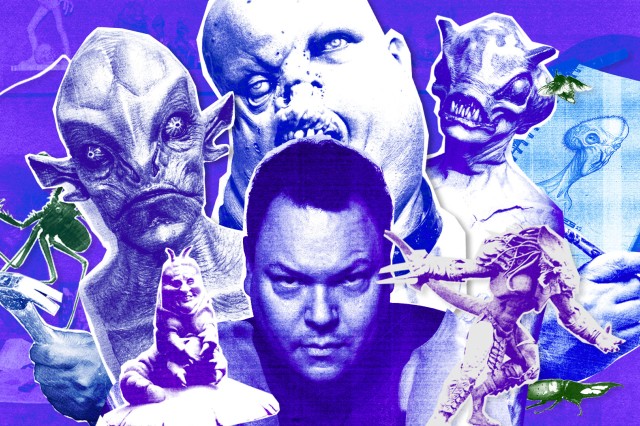
STORY
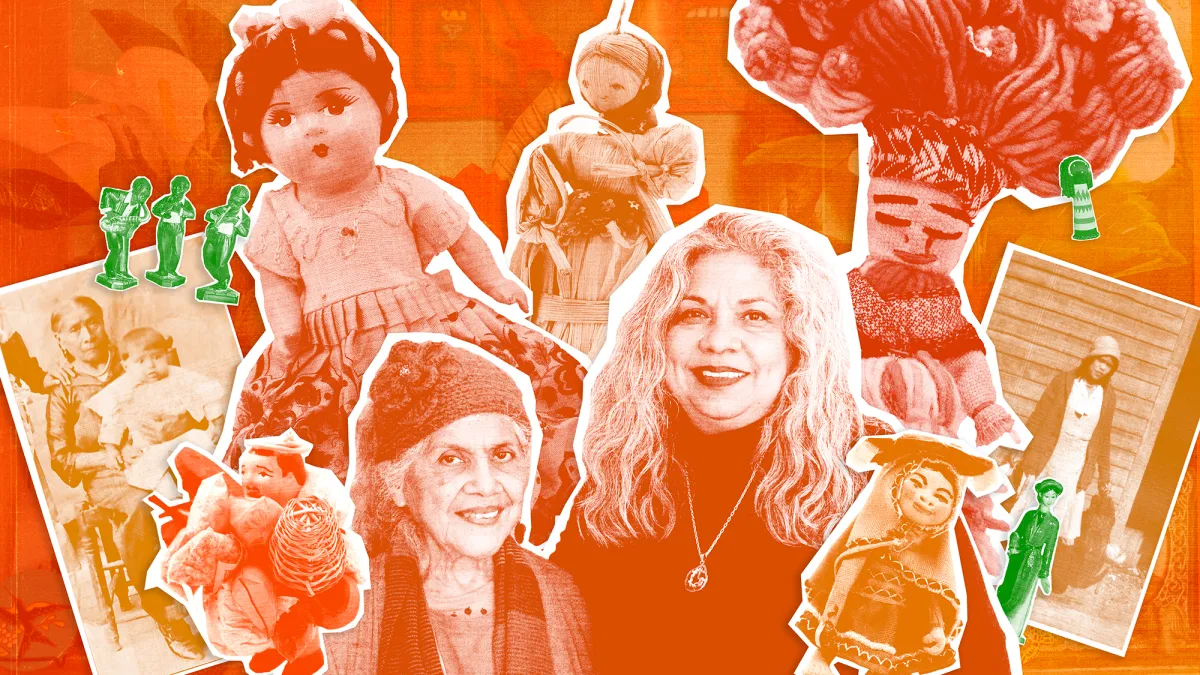
To Ofelia Esparza and her daughter Rosanna Esparza Ahrens, dolls are much more than simple playthings. Through their practice as artists and altaristas (altar-makers), Rosanna and Ofelia regularly use dolls as conduits of heritage, memory, and self-identity. Ofelia Esparza is legendary in the arts and culture scene of Los Angeles. For more than seventy years, in the same neighborhood in East Los Angeles, she has been enlivening the minds and spirits of the global community that is Los Angeles through her work both as an artist and as an educator. Ofelia’s preferred medium is the Mexican Day of the Dead-inspired ofrenda (altar). Rosanna also shares her mother’s passion for creating bespoke ofrendas.
In 2017, Ofelia and Rosanna were commissioned by the Natural History Museum to create a permanent, onsite ofrenda to celebrate the cultural diversity of Los Angeles. The Esparzas routinely include dolls in their altars, including the one they made in the Museum, because of their globally accessible symbolic value.
Although Rosanna and Ofelia are artists in their own right, they are also avid doll collectors, largely of the handmade variety. The Esparza’s are curators of an impressive gathering of traditional dolls from many different cultures, often constructed with little more than the essential components: cloth, fabric, thread, and pigment.
[Handmade dolls] are not mass-produced. It tells something about the people, of the creator, of the process. Creativity for me is key. The materials are sometimes used in a very innovative way.
Ofelia Esparza

We spoke with Ofelia and Rosanna to learn more about where their love of dolls originated and how these small creations can inspire reflections on identity and heritage. Click here or on the link above to watch these acclaimed artists discuss their appreciation for dolls and the craft of doll making.
The cultural capital that we have as different cultures, we bring into the story [through] textiles and traditional clothing.
Rosanna Esparza Ahrens
In 2017, the Natural History Museum commissioned Rosanna and Ofelia to create a permanent ofrenda, or altar, to the City of Los Angeles. Explore the dolls included in the altar created by Ofelia and Rosanna dedicated to the bountiful diversity of Los Angeles.
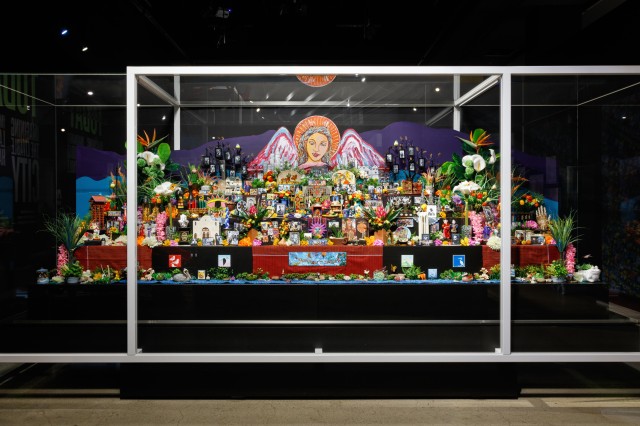
Natural History Museum of Los Angeles County
This multi-tiered altar, on permanent display at the Natural History Museum of Los Angeles County, pays homage to the multi-cultural diversity of Los Angeles.
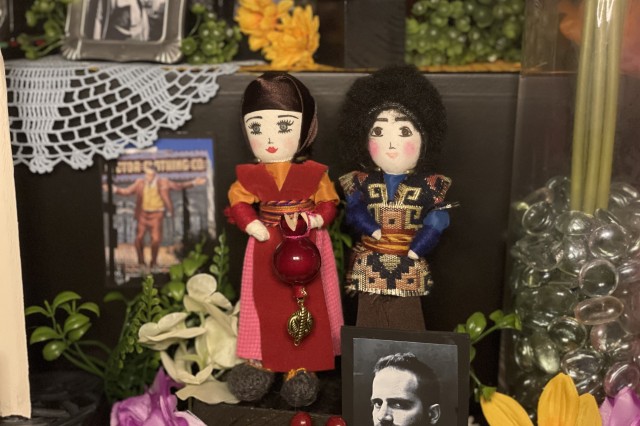
Natural History Museum of Los Angeles County
These two dolls are garbed in traditional Armenian dress. Rosanna and Ofelia bought these dolls at a shop in Glendale, California, to include them in their altar at the Museum. Los Angeles is home to the largest population of Armenians in the United States.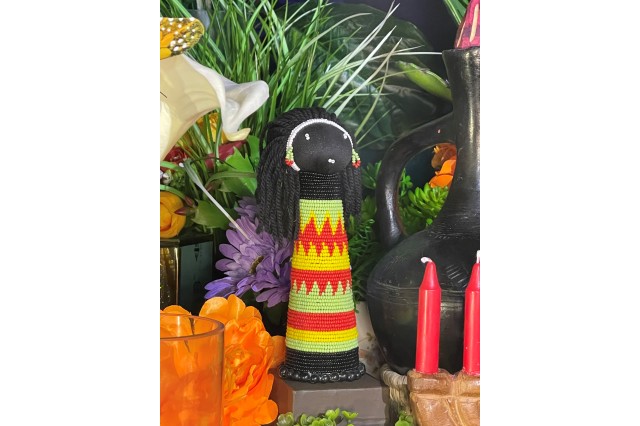
Natural History Museum of Los Angeles County
Ofelia donated this beautifully crafted African doll that is made up of hundreds of carefully placed beads. The hair is made of yarn.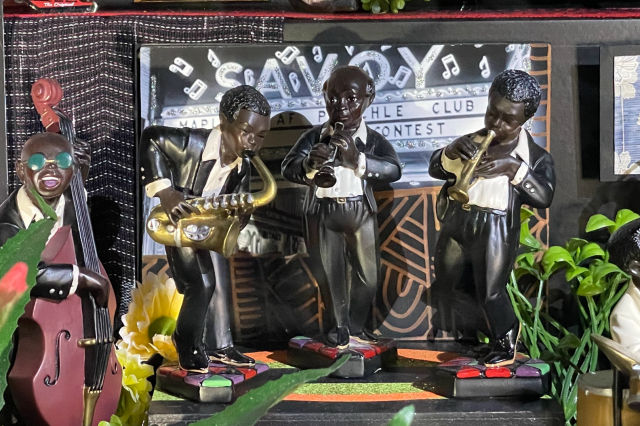
Natural History Museum of Los Angeles County
Harkening back to the lively jazz scene of Los Angeles’ Central Avenue, a lively jazz ensemble plays an eternal gig in the Esparza’s altar. “I loved those,” says Ofelia of the figurines.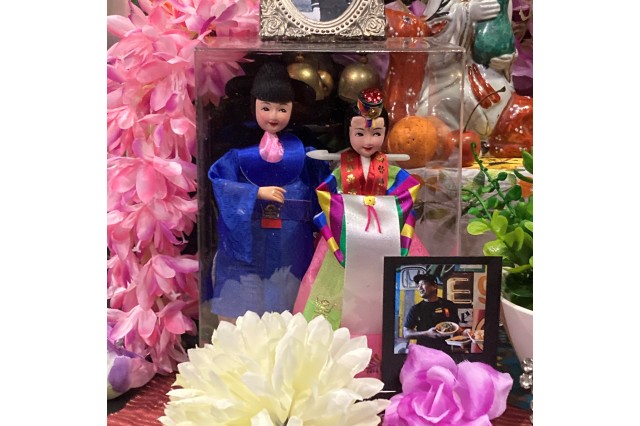
Natural History Museum of Los Angeles County
Ofelia donated these stately Korean dolls to the altar to honor the thriving Korean population in Los AngelesNatural History Museum of Los Angeles County
A simply constructed but beautifully adorned handmade Mexican rag doll is also a part of Ofelia’s personal collection.1 of 1
This multi-tiered altar, on permanent display at the Natural History Museum of Los Angeles County, pays homage to the multi-cultural diversity of Los Angeles.
Natural History Museum of Los Angeles County
Natural History Museum of Los Angeles County
Natural History Museum of Los Angeles County
Natural History Museum of Los Angeles County
Natural History Museum of Los Angeles County
Natural History Museum of Los Angeles County
Ofelia has been collecting dolls ever since she was a child; she now estimates she has over 200 dolls of all kinds. Explore Ofelia’s wonderfully eclectic doll collection.
Natural History Museum of Los Angeles County
This Bolivian doll came into Ofelia’s collection by way of her mother, who bought it in Mexico. It represents a street vendor laden down with his wares for purchase.
Natural History Museum of Los Angeles County
This doll with a floral print dress was bought in Cuahtemoc, a municipality in Mexico City.
Natural History Museum of Los Angeles County
Ofelia purchased this doll from a roadside vendor while passing through a Navajo reservation. The doll's velveteen dress is complemented by its intricately crafted necklace and earrings.
Natural History Museum of Los Angeles County
This joyful, vaguely simian doll features articulating arms. “I love goofy dolls,” says Ofelia Esparza, “I love that it shows the handprints [of its maker].”
Natural History Museum of Los Angeles County
This doll is in the image of a Zapatista from the highlands of Chiapas, Mexico. The Zapatistas are a political and sometimes militant (as evidenced by the miniature rifle) political group that advocates for Indigenous rights in Mexico.
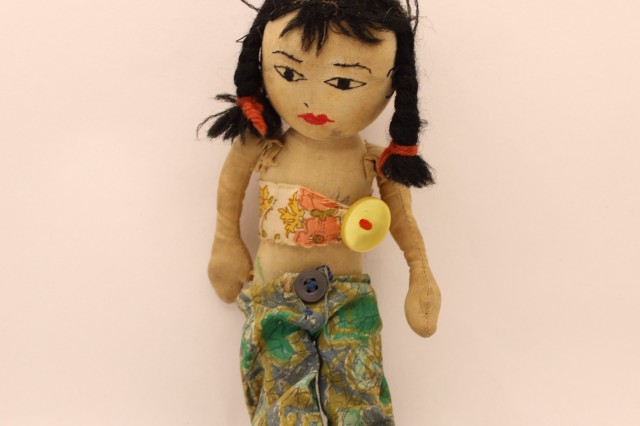
Natural History Museum of Los Angeles County
Ofelia estimates this well-loved doll to be at least a hundred years old. It had been undressed by her granddaughter, who misplaced the traditional top, which explains this doll’s more modern outfit.
Natural History Museum of Los Angeles County
This doll was collected from Guanajuato, Mexico, by Ofelia’s mother, Guadalupe. This doll portrays a woman in the act of grinding corn into fine flour using a grinding stone. Notice the care with which the lace decoration was applied to the figure’s blouse.
Natural History Museum of Los Angeles County
Not all Ofelia’s dolls are made of cloth. This Japanese doll is made of wood that has been painted.
Natural History Museum of Los Angeles County
Aside from two bits of fabric, this doll is made entirely of dried corn husks. Dolls like this attest to Ofelia’s appreciation of hand-crafted dolls made of natural materials.
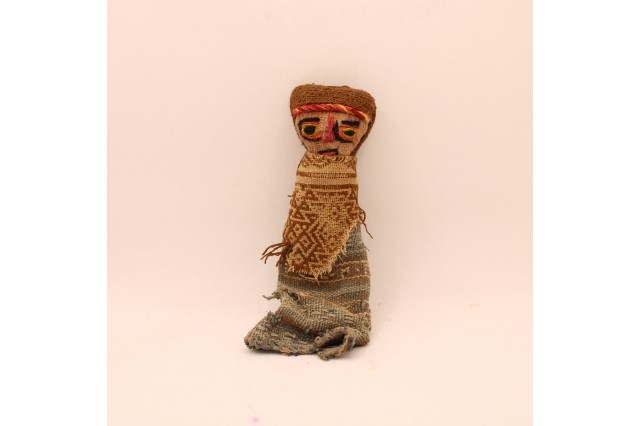
Natural History Museum of Los Angeles County
This doll was brought to Ofelia by her daughter who bought it in Peru. The doll is stuffed with dried grasses and adorned in fabrics from which the human-sized clothing of that particular Peruvian region would be made.
Natural History Museum of Los Angeles County
“Isn’t she darling?” asks Ofelia of this doll she bought in 1994. This doll of a kind-faced older woman is from Peru and is made of clay, yarn, and fabric.
Natural History Museum of Los Angeles County
Ofelia bought this handmade African doll at a street festival. She often seeks dolls constructed of organic materials such as husks, natural fibers, grasses, feathers, and wood.
Natural History Museum of Los Angeles County
This is a doll of a Peruvian man in a traditional woolen dress, complete with a drum and cap. Ofelia values dolls such as these because the miniature clothing the doll wears is often made with the same fabric or textile as its human-sized counterpart.
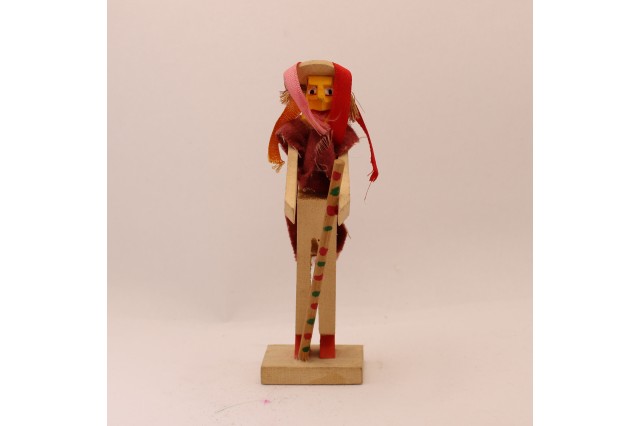
Natural History Museum of Los Angeles County
This wooden doll depicts the costume of a traditional dance from Michoacan, Mexico. The dancer of the, Danza de los Viejitos, or, the Dance of the Old Men, adorns himself with this traditional costume which includes a cane, a hat with bright tassels, a serape, flat wooden sandals, and a garish mask.
1 of 1
This Bolivian doll came into Ofelia’s collection by way of her mother, who bought it in Mexico. It represents a street vendor laden down with his wares for purchase.
Natural History Museum of Los Angeles County
This doll with a floral print dress was bought in Cuahtemoc, a municipality in Mexico City.
Natural History Museum of Los Angeles County
Ofelia purchased this doll from a roadside vendor while passing through a Navajo reservation. The doll's velveteen dress is complemented by its intricately crafted necklace and earrings.
Natural History Museum of Los Angeles County
This joyful, vaguely simian doll features articulating arms. “I love goofy dolls,” says Ofelia Esparza, “I love that it shows the handprints [of its maker].”
Natural History Museum of Los Angeles County
This doll is in the image of a Zapatista from the highlands of Chiapas, Mexico. The Zapatistas are a political and sometimes militant (as evidenced by the miniature rifle) political group that advocates for Indigenous rights in Mexico.
Natural History Museum of Los Angeles County
Ofelia estimates this well-loved doll to be at least a hundred years old. It had been undressed by her granddaughter, who misplaced the traditional top, which explains this doll’s more modern outfit.
Natural History Museum of Los Angeles County
This doll was collected from Guanajuato, Mexico, by Ofelia’s mother, Guadalupe. This doll portrays a woman in the act of grinding corn into fine flour using a grinding stone. Notice the care with which the lace decoration was applied to the figure’s blouse.
Natural History Museum of Los Angeles County
Not all Ofelia’s dolls are made of cloth. This Japanese doll is made of wood that has been painted.
Natural History Museum of Los Angeles County
Aside from two bits of fabric, this doll is made entirely of dried corn husks. Dolls like this attest to Ofelia’s appreciation of hand-crafted dolls made of natural materials.
Natural History Museum of Los Angeles County
This doll was brought to Ofelia by her daughter who bought it in Peru. The doll is stuffed with dried grasses and adorned in fabrics from which the human-sized clothing of that particular Peruvian region would be made.
Natural History Museum of Los Angeles County
“Isn’t she darling?” asks Ofelia of this doll she bought in 1994. This doll of a kind-faced older woman is from Peru and is made of clay, yarn, and fabric.
Natural History Museum of Los Angeles County
Ofelia bought this handmade African doll at a street festival. She often seeks dolls constructed of organic materials such as husks, natural fibers, grasses, feathers, and wood.
Natural History Museum of Los Angeles County
This is a doll of a Peruvian man in a traditional woolen dress, complete with a drum and cap. Ofelia values dolls such as these because the miniature clothing the doll wears is often made with the same fabric or textile as its human-sized counterpart.
Natural History Museum of Los Angeles County
This wooden doll depicts the costume of a traditional dance from Michoacan, Mexico. The dancer of the, Danza de los Viejitos, or, the Dance of the Old Men, adorns himself with this traditional costume which includes a cane, a hat with bright tassels, a serape, flat wooden sandals, and a garish mask.
Natural History Museum of Los Angeles County
And then you pass it on to someone and hopefully the person or the child or adult who receives that will keep it and maybe pass it on themselves. But it's a learning process. It's a treasure of cultural pride and history. So that's how I've seen dolls throughout my life.
Ofelia Esparza
Although Ofelia enjoys every one of her dolls, there are several in her collection for which she has a special place in her heart. These are dolls which have a direct and personal connection with Ofelia and her family. This family connection is a significant inspiration for Ofelia’s love for dolls, and it all started with the dolls her mother would hand-make for her during Christmastime.
Courtesy of Rosanna Esparza Ahrens
These two dolls were made for Rosanna and Ofelia by their friend Xochi Flores. Xochi made the doll's clothing out of textiles that were given to her by Ofelia, who in turn inherited them from her mother, Guadalupe Salazar. The dolls are crafted in the likenesses of Ofelia (left) and Rosanna (right).
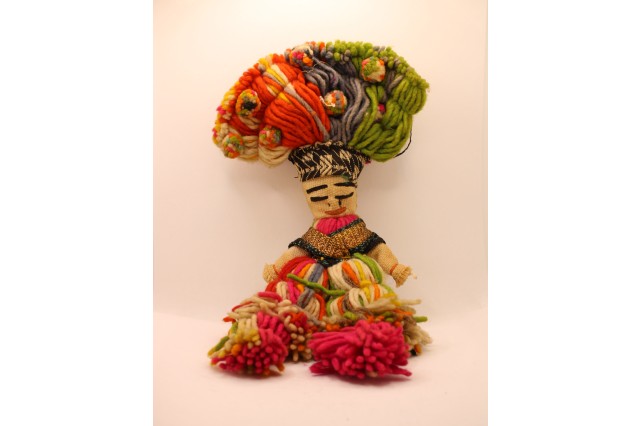
Natural History Museum of Los Angeles County
This doll was handmade by Ofelia’s mother, Guadalupe Salazar. It was made from fabric and yarn scraps and represents a traditional dancer from Guanajuato, Mexico. According to Ofelia, “I learned about my heritage through those dolls because my mother would talk about them, and then she would make dolls herself.”
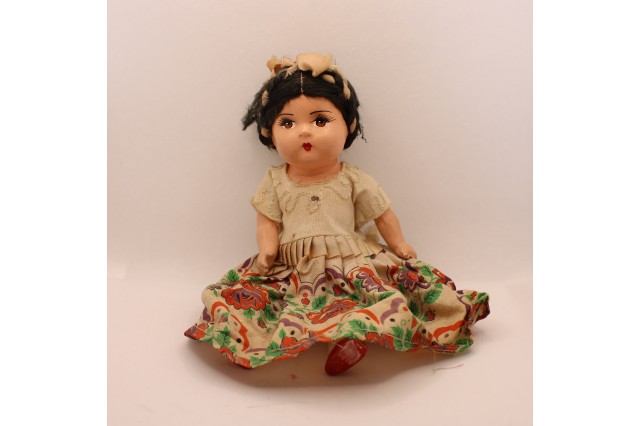
Natural History Museum of Los Angeles County
Ofelia estimates this doll to be the oldest in her collection at approximately 100 years old, original clothing still intact. It was given to her by her mother, Guadalupe Salazar, who brought it from Guanajuato, Mexico.
Natural History Museum of Los Angeles County
Ofelia was gifted this handmade paper doll of her own likeness by her granddaughter.
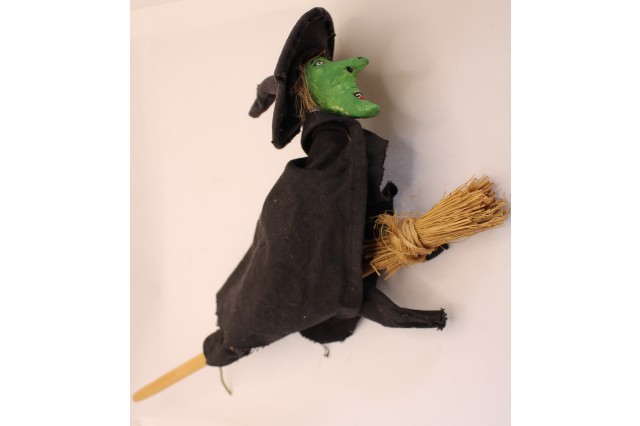
Natural History Museum of Los Angeles County
This doll of a witch riding a broomstick was made by Ofelia’s son about 40 years ago. “All my kids are artists,” replied Ofelia when asked if her son still makes art.
1 of 1
These two dolls were made for Rosanna and Ofelia by their friend Xochi Flores. Xochi made the doll's clothing out of textiles that were given to her by Ofelia, who in turn inherited them from her mother, Guadalupe Salazar. The dolls are crafted in the likenesses of Ofelia (left) and Rosanna (right).
Courtesy of Rosanna Esparza Ahrens
This doll was handmade by Ofelia’s mother, Guadalupe Salazar. It was made from fabric and yarn scraps and represents a traditional dancer from Guanajuato, Mexico. According to Ofelia, “I learned about my heritage through those dolls because my mother would talk about them, and then she would make dolls herself.”
Natural History Museum of Los Angeles County
Ofelia estimates this doll to be the oldest in her collection at approximately 100 years old, original clothing still intact. It was given to her by her mother, Guadalupe Salazar, who brought it from Guanajuato, Mexico.
Natural History Museum of Los Angeles County
Ofelia was gifted this handmade paper doll of her own likeness by her granddaughter.
Natural History Museum of Los Angeles County
This doll of a witch riding a broomstick was made by Ofelia’s son about 40 years ago. “All my kids are artists,” replied Ofelia when asked if her son still makes art.
Natural History Museum of Los Angeles County
Much like Rosanna and Ofelia Esparza, the Natural History Museum of Los Angeles County also takes care of a large and varied collection of traditional dolls and figurines. These dolls, each unique to their time and place, are currently held in the Natural History Museum’s History (Material Culture) and Ethnology Collections.
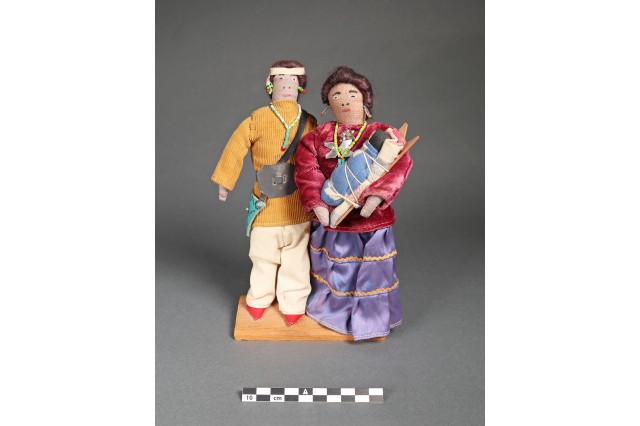
Natural History Museum of Los Angeles County, Anthropology Collection: Ethnology
A male and female doll couple that are both attached at their feet to the same wooden base. Their style of dress and accessories look similar to basic Navajo (Diné) attire for men and women in the mid 1900s.
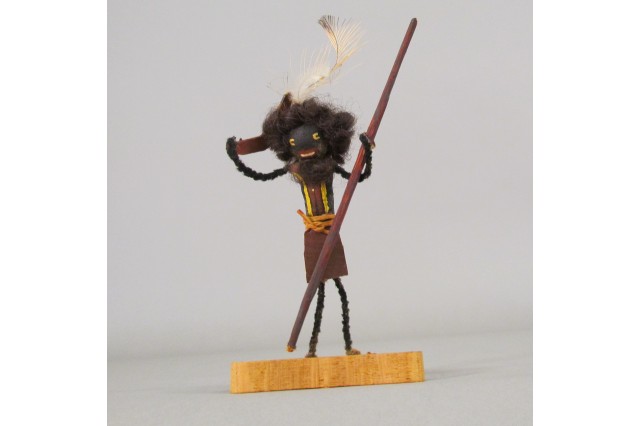
Natural History Museum of Los Angeles County, History Collection: Material Culture
This doll’s records indicate that this 4’’ tall pipe cleaner doll named “Moopil” was made by the Sarah Midgley Budgerree Doll Company. In the 1870s, English-born Sarah Midgely settled with her family in a small town off in the Shire of Noosa in Queensland, Australia. A young Sarah befriended members of the local Indigenous community and as an adult, she began making dolls in their image, and was soon selling them to doll collectors around the world.
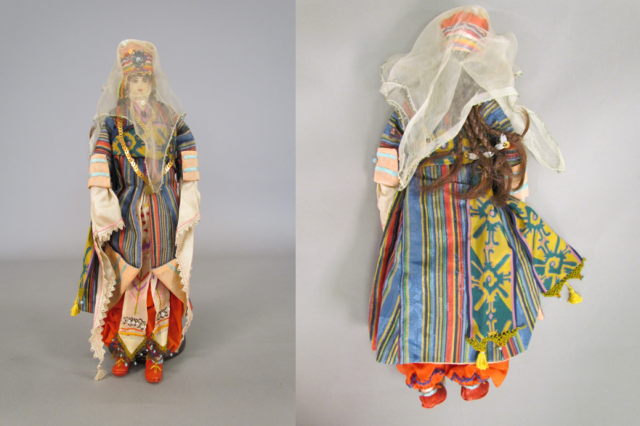
Natural History Museum of Los Angeles County, History Collection: Material Culture
This handmade doll crafted from bits of fabric, beads, and human hair illustrates the complicated history and heritage of the Caucasus region. Cataloged among Turkish dolls, she is described as wearing Kurdish-style clothing and was made by an Armenian woman in 1932.

Natural History Museum of Los Angeles County, Anthropology Collection: Ethnology
Collected in 1957, this pair of dolls shows the regional attire of Puebla, Mexico.
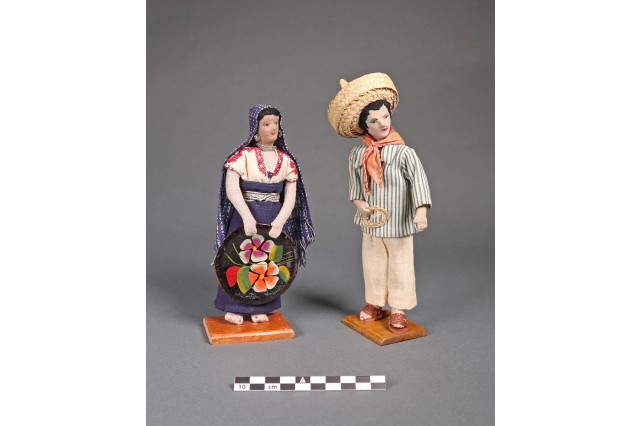
A similar pair of dolls, also collected by the Museum in 1957, showcase the regional attire of Michoacan, Mexico.
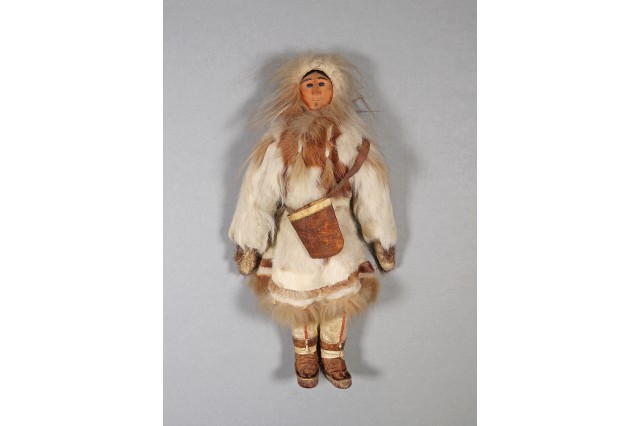
Natural History Museum of Los Angeles County, Anthropology Collection: Ethnology
This doll from the early 1900s is wearing the traditional attire for a Bering Strait area Inuit woman, including a customary women’s chin tattoo.
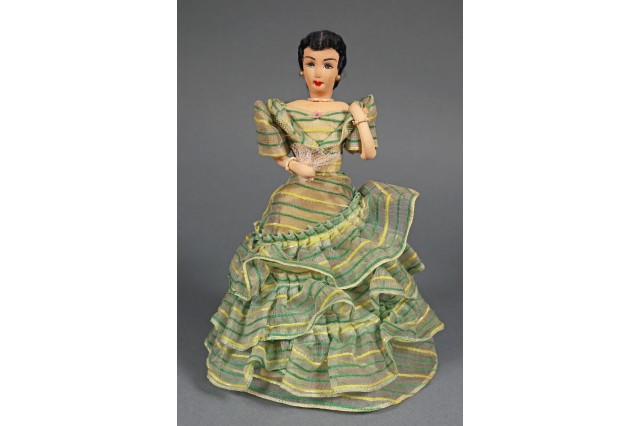
Natural History Museum of Los Angeles County, Anthropology Collection: Ethnology
This early 20th-century Filipina doll is wearing a traditional Jusi-style dress. Jusi clothing was originally made of banana leaf fibers. For precious items, a labor-intensive piña fabric was made from fibers hand-extracted from a special kind of pineapple leaf.
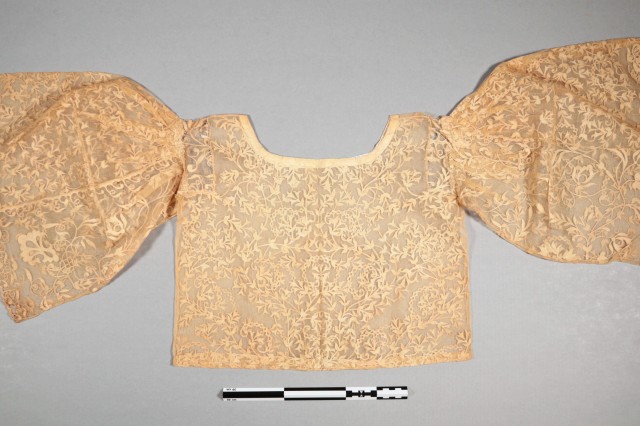
Natural History Museum of Los Angeles County, Anthropology Collection: Ethnology
The Jusi blouse’s delicate and sheer background material consists of delicately woven piña fiber, while linen is used for shadow applique decoration. This particular blouse made in the 1910s traces its roots to the Indigenous peoples of the Cordillera Mountain Range of northern Luzon, Philippines.
1 of 1
A male and female doll couple that are both attached at their feet to the same wooden base. Their style of dress and accessories look similar to basic Navajo (Diné) attire for men and women in the mid 1900s.
Natural History Museum of Los Angeles County, Anthropology Collection: Ethnology
This doll’s records indicate that this 4’’ tall pipe cleaner doll named “Moopil” was made by the Sarah Midgley Budgerree Doll Company. In the 1870s, English-born Sarah Midgely settled with her family in a small town off in the Shire of Noosa in Queensland, Australia. A young Sarah befriended members of the local Indigenous community and as an adult, she began making dolls in their image, and was soon selling them to doll collectors around the world.
Natural History Museum of Los Angeles County, History Collection: Material Culture
This handmade doll crafted from bits of fabric, beads, and human hair illustrates the complicated history and heritage of the Caucasus region. Cataloged among Turkish dolls, she is described as wearing Kurdish-style clothing and was made by an Armenian woman in 1932.
Natural History Museum of Los Angeles County, History Collection: Material Culture
Collected in 1957, this pair of dolls shows the regional attire of Puebla, Mexico.
Natural History Museum of Los Angeles County, Anthropology Collection: Ethnology
A similar pair of dolls, also collected by the Museum in 1957, showcase the regional attire of Michoacan, Mexico.
This doll from the early 1900s is wearing the traditional attire for a Bering Strait area Inuit woman, including a customary women’s chin tattoo.
Natural History Museum of Los Angeles County, Anthropology Collection: Ethnology
This early 20th-century Filipina doll is wearing a traditional Jusi-style dress. Jusi clothing was originally made of banana leaf fibers. For precious items, a labor-intensive piña fabric was made from fibers hand-extracted from a special kind of pineapple leaf.
Natural History Museum of Los Angeles County, Anthropology Collection: Ethnology
The Jusi blouse’s delicate and sheer background material consists of delicately woven piña fiber, while linen is used for shadow applique decoration. This particular blouse made in the 1910s traces its roots to the Indigenous peoples of the Cordillera Mountain Range of northern Luzon, Philippines.
Natural History Museum of Los Angeles County, Anthropology Collection: Ethnology
The L.A. at Play story is not complete without you! Share your creature, doll, or figurine story and follow the stories of the makers who are contributing to some of L.A.'s most iconic fandoms. Tag us @NHMLA with #LAatPlay.